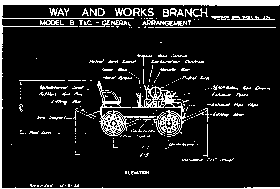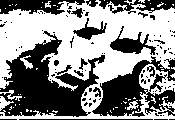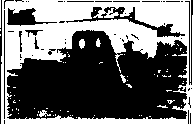|
|
|

|
Preservation and Restoration of NSW Railway Track Vehicles |
|
NSWGR Trikes |

|
©Copyright NSWGR Trikes 2016 |
|
Trikes and Trolleys A short history of track vehicles on the NSWGR
by Greg Lee |
|
Chapter 4 T.I.C.s, S.I.C.s and Trailers
The existence of the track tends to be taken for granted by many who are interested in railways. Yet without track no train could run, and so the track and more particularly its maintenance deserves some consideration.
In N.S.W. the state is divided up into “Divisions” for track maintenance purposes. Each Division is under the control of a Division Engineer. The number of Divisions and their boundaries have changed many times over the years. Division Engineers have at times in the past been known as Maintenance Engineers and also Resident Engineers.
In days gone by, heavy maintenance and renewals (re-sleepering, re-railing and ballast reconditioning) were carried out by special “extra gangs” of at least 20 labourers. Minor maintenance and day to day housekeeping were carried out by small gangs (usually 5 men) of fettlers, under the control of a fettling ganger. The fettling ganger was directly responsible for the condition of his “length” of track. He, or one of his men, was required to ride over the length by trike every day to observe the state of the track, and look for defects. This was called “running the length” or “running the road”. Before the introduction of motor transport, lengths were of necessity short. They were normally 7 miles, on both main lines and branch lines.
With the introduction of motor transport it became feasible to make the lengths longer. When motor trikes were provided there was some amalgamation of fettling gangs, and typical lengths became 10 miles for mainline, and 20 miles for branch line. Lengths could be longer or shorter than these figures, depending on the circumstances, such as grades and terrain.
The vehicle known as the Towing Inspection Car or T.I.C. was introduced some time prior to 1936. The T.I.C.s were possibly based on the "Buda" Inspection Cars, which had been introduced some time earlier. Very little is known about the Buda cars.
T.I.C.s were originally used by fettling gangs on some of the branch lines in outlying areas of the state. As well as being used to inspect the length, they were used to take the gang to their place of work for the day. The gang and their tools were accommodated on a trailer which was towed behind the T.I.C. The trailer was fitted with a central longitudinal bench for the fettlers to sit on, while the tools were carried under the bench.
Three different types of trailers were used. The first were bought from an outside supplier, and had 20" spoked wooden wheels. The second were made from Sheffield trolleys. Both of these types of trailers were designated as Heavy type.
The third type was the Light Gang Trailer or LGT which were built at Goulburn Per Way workshops. These had 14" wooden spoked wheels. There were several changes to design over the years of manufacture. Over 900 were built. All three types of trailer had ball bearing axle boxes, and some form of braking arrangement. (Note: More detail about trailers will be added here.)
All T.I.C.s were built at Goulburn Per Way Workshops. Indeed the first NSWGR built T.I.C.s were originally known as the “Goulburn Type”, but were later designated “Type A”. They had a tubular frame and a 3-1/2 H.P. air cooled two stroke Villiers engine, with a Burman model “Q” gearbox. Starting was by a kick starter on the gearbox, with the final drive being by chain to the rear axle. “Type A” T.I.C.s had only one seat and were permitted to carry only one person. All later T.I.C.s had two seats and were permitted to carry two people.
In 1948 the “Type B” T.I.C. was introduced. They had a steel channel frame and better seating and braking arrangements. Mechanical details were the same as for the “Type A”. See Figure 1.(Blue print of Type B T.I.C.plan)
Some difficulties were experienced with the Villiers engines. Overheating was a common problem, and instructions were repeatedly issued concerning procedures to be followed to avoid overheating. The engines were lubricated by means of an automatic oil feed, but damage occurred to the pistons due to insufficient lubrication. On 11 August 1936 instructions were issued that oil was to be added to the petrol at the rate of 1 pint of oil to 5 gallons of petrol (1:40) to provide extra lubrication.
A new type of TIC known as the "Mark 54" was introduced in 1954. Very little is known about these, and they do not appear to be mentioned in NSWGR literature after 1958. Either they were very short lived, or their classification was amalgamated with that of one of the other types of TIC.
In 1956 the “T.I.C. Mark 56” was introduced. These had a light channel frame, and were poweredby a 4-1/2 H.P. aircooled, four stroke B.S.A. engine, with an Albion model “HR” gearbox. Starting was by rope to the starting pulley on the engine. See Figure 2. (Photo of ‘56 T.I.C. taken by R.W. at Glenreagh)
In 1960 the “T.I.C. Mark 60” was introduced. These were similar to the Mark 56, but had wider seats and floors, and were powered by an aircooled, four stroke Wisconsin engine. See Figure 3. (B&W photo at Goulburn) In 1961 Division Engineers were asked to advise which of their “Type A” T.I.C.s were in urgent need of replacement so that a priority for allocation of Mark 60 T.I.C.s could be determined.
T.I.C.s were originally permitted to travel at speeds up to 20 m.p.h., but due to overheating problems this was decreased to 15 m.p.h., when laden. By 1963 the maximum speed for all T.I.C.s had been increased to 30 m.p.h.
The controls of T.I.C.s were set up similarly to those of a motor car. They had a foot pedal for the clutch, and another for the brake. The gear lever extended directly from the gearbox, in the centre of the car. A handbrake lever was also provided in the centre of the car. The throttle was hand operated. The braking arrangement on T.I.C.s consisted of a small wooden brake block on each of the wheels. As with quadricycles, the brake blocks initially had a leather lining, but this was later changed to a Ferrodo lining, which was found to be better. Braking performance was similar to that of quads; that is in flat country, and in dry conditions the brakes were satisfactory. In the wet and on grades they were poor. On some Divisions the trike mechanics took it upon themselves to fit Fairmont cast iron brake shoes to T.I.C.s. These dramatically improved the braking performance.
Up until the early 1960s virtually all track maintenance work was carried out manually. There were no machines of any sort (except for motor trikes). With the advent of small and lightweight internal combustion engines the use of machines such as air compressors became feasible. Thus a programme of mechanisation and amalgamation of fettling gangs was embarked on. Several adjoining “lengths” would be amalgamated into one “mechanised” length. The fettlers were provided with a modern new gang shed featuring such conveniences as hot water, toilets and showers. This was a vast improvement from the trolley shed, which did not even feature a pan toilet. Machines were provided in the form of “spot air” compressors, and air tools. Mechanical rail borers, rail saws, and sleeper borers were also provided. Usually a motor lorry was provided for gang transport, to allow greater distances to be covered more quickly. Unfortunately road access to and along the track was usually not provided until much later. In flat country this was not a great problem, as it was usually possible to drive along next to the track. However in hilly country such as the North coast, road access to many parts of the track was impossible. There are still many parts of the North coast line that are difficult to access by road.
By the late 1970s most fettling gangs had been amalgamated. However, fettling gangs north of Armidale remained non mechanised until regular services ceased in October 1989, when the gangs were closed down. The last fettling gangs under the control of NSWGR to succumb to mechanisation were those between Border Loop and Brisbane where amalgamation occurred in the early 1990s.
Typical main line mechanised lengths are of 40 to 60 km. In outback areas, and on branch lines they can be over 100 km. These increased lengths meant that “running the length” became almost a full time job. Thus with mechanisation and amalgamation of the fettling gangs came structural change also. To each gang was appointed a “Track Supervisor” whose job it was to run the length, and systematically inspect the track. An unfortunate side effect of this was that the fettling ganger who had hitherto often had great pride in the condition of his length, was no longer in charge of the length. Inevitably many gangers lost interest in condition of the length.
Track Supervisors have used many different types of transport to inspect their lengths. Up until the late 1970s quads were by far the most common form of transport. T.I.C.s were also commonly used. To accommodate Track Supervisors Goulburn Workshops especially built the Supervisors’ Inspection Car or S.I.C. This was basically a T.I.C. Mark 60 with a fibreglass canopy fitted, for protection of the supervisor and his driver from the elements. S.I.C.s towed special trailers called Supervisors Inspection Trailers or S.I.T.s. These trailers were provided to carry the Supervisors’ tools and equipment, and were fitted with a special tarpaulin so that the supervisor’s tools were also protected from the weather. See Figure 4. (B&W photo)
The manufacture of S.I.C.s began in the early 1960s, and continued until Goulburn Per Way Workshops closed in the early 1980s. S.I.C.s afforded an increased level of comfort and convenience to the Supervisors. For this reason they were originally allocated to the Supervisors with the longer lengths, since they had to spend greater amounts of time inspecting their track.
Most track supervisors in N.S.W. ceased regular use of TICs or SICs when they were provided with Hyrail vehicles. These are a standard four wheel drive road vehicle which has retractable rail wheels fitted to it. They provide a greater level of versatility in transport as they allow track supervisors to travel by either road or rail. They also provide all the comforts of a modern road vehicle. They were first introduced in N.S.W. in the late 1970s, or early 1980s but their use did not become widespread until the mid 1980s.
ACKNOWLEDGMENTS Errol Hall, Tregeagle (Lismore). Teddy Martin, Goulburn. Alan Robinson, Bathurst. Stan Souter, Mittagong. Eddy Tracey, Glenreagh.
FOOT NOTE Since this chapter was written, there has been further structural change to track maintenance on the Government railways in NSW. At the present time (1999) changes are occurring regularly, particularly in the area of terminology, and there seems little point in documenting all of them. Suffice to say that in some locations maintenance is now carried out by contractors, while the remaining government maintenance has been greatly rationalised.
Figure 1. Figure 2.
Figure 3. Figure 4. |
|
© Greg Lee, 1992 - 1999 |



